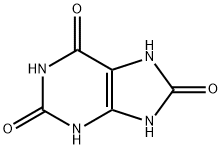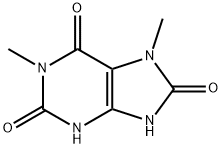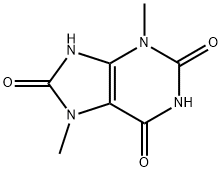A8323312
Uric acid , 99% , 69-93-2
Synonym(s):
2,6,8-Trihydroxypurine
CAS NO.:69-93-2
Empirical Formula: C5H4N4O3
Molecular Weight: 168.11
MDL number: MFCD00005712
EINECS: 200-720-7
| Pack Size | Price | Stock | Quantity |
| 5G | RMB63.20 | In Stock |
|
| 25G | RMB197.60 | In Stock |
|
| 100G | RMB636.80 | In Stock |
|
| 500g | RMB2799.20 | In Stock |
|
| others | Enquire |
Update time: 2022-07-08
PRODUCT Properties
| Melting point: | >300 °C (lit.) |
| Boiling point: | 297.02°C (rough estimate) |
| Density | 1,9 g/cm3 |
| refractive index | 1.9900 (estimate) |
| storage temp. | Sealed in dry,2-8°C |
| solubility | Aqueous Base (Sparingly, Heated) |
| form | crystalline |
| pka | 3.89(at 12℃) |
| color | White to off-white |
| Odor | Odorless |
| biological source | animal (seabird feces (guano)) |
| Water Solubility | Soluble in 1M sodium hydroxide solution. Slightly soluble in water. Insoluble in ether and alcohol. |
| Merck | 14,9875 |
| BRN | 156158 |
| Stability: | Stable. Incompatible with acids, bases, oxidising agents. |
| Cosmetics Ingredients Functions | SKIN CONDITIONING BUFFERING |
| LogP | -1.730 (est) |
| CAS DataBase Reference | 69-93-2(CAS DataBase Reference) |
| EPA Substance Registry System | Uric acid (69-93-2) |
Description and Uses
Uric Acid is a heterocyclcic compound that is created when purine nucleotides are broken down of by the human body. High blood concetration of Uric Acid is known as hyperuricemia and is often associated with a wide range of disorders and medical conditions such as gout, diabetes and metabolic syndrome. Uric acid may be a marker of oxidative stress and may have a potential therapeutic role as an antioxidant.
Safety
| Symbol(GHS) |  GHS07 |
| Signal word | Warning |
| Hazard statements | H302-H315-H319-H332-H335 |
| Precautionary statements | P261-P280-P305+P351+P338 |
| Hazard Codes | Xi |
| Risk Statements | 33-36/37/38 |
| Safety Statements | 24/25-36-26 |
| WGK Germany | 3 |
| RTECS | YU7050080 |
| TSCA | Yes |
| HS Code | 29339900 |
| Toxicity | A nitrogenous end product and the principal excretory product of purine metabolism in mammals. In birds and reptiles, it is the principal end product of nitrogen metabolism in general. Defects in uric acid metabolism and excretion appear to be associated with a number of disease states, and it frequently occurs as a component of renal calculi. It has not been associated closely with toxic insults except in the case of lead poisoning. Lead causes an elevation in blood uric acid concentration (uric acidemia) and a decrease in uric acid excretion. |




